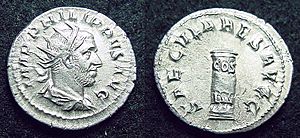Roman consul facts for kids


A Roman consul was the most important elected leader in the Roman Republic. Think of them like the highest-ranking presidents or prime ministers of their time.
Every year, two consuls were chosen to serve for one year. They shared power, and each consul could stop (or "veto") what the other wanted to do. They also took turns leading each month.
Most consuls came from rich, noble families called patricians. But after 367 BC, ordinary people, known as plebeians, could also become consuls.
Consuls had a lot of power. In times of peace, they managed the government, made laws, and acted as judges. During war, they were often the top military commanders. They also performed important religious ceremonies and read signs from the gods (called auguries) before battles.
Contents
What Did Roman Consuls Do?
Leading the Government
Consuls had the power to call meetings of the Roman Senate. They also led these meetings, with each consul taking a month to be in charge. They could also gather any of the Roman public assemblies and lead them.
This meant consuls were in charge of elections. They also put new laws up for a vote. If both consuls were out of the city, a special official called the praetor urbanus took over their duties.
Symbols of Power
Every time a consul appeared in public, twelve special guards called lictors were with him. These guards showed how important the consul was and kept him safe. Each lictor carried a bundle of rods with an axe inside, called a fasces.
The rods in the fasces showed the consul's power to whip people. The axe showed his power to order severe punishments. However, inside the city, the axes were removed from the fasces. This showed that a Roman citizen could not be put to death without a fair trial. When consuls entered a public meeting, their lictors would lower the fasces. This was a sign that the consuls' power came from the Roman people.
Consuls as Military Leaders
Outside the city of Rome, consuls had even greater power. They were the main commanders of all the Roman legions. In this role, consuls had full imperium, which meant complete authority.
Leading the Army
When the Senate decided to raise armies, the consuls were in charge of gathering the soldiers. All soldiers had to promise loyalty to the consuls when they joined the army. Consuls also oversaw the troops provided by Rome's allies.
Inside Rome, a consul could arrest a citizen or order them to be punished. But they could not order a citizen's death. However, when they were on a military trip, a consul could order any punishment they thought was right for any soldier, officer, or ally.
Each consul usually commanded an army of two legions. They had help from military officers and a quaestor, who handled money matters. If both consuls led an army together, they would take turns commanding for a day. A typical consular army had about 20,000 soldiers, including Roman citizens and allied troops.
Expanding Roman Lands
In the early days of the Republic, Rome's enemies were close by in central Italy. So, military trips usually lasted only a few months. As Rome grew, these campaigns became longer.
Rome was a society that often went to war. So, when a consul took office, everyone expected him to lead his army against Rome's enemies. The goal was to expand Roman lands. Soldiers also hoped to return home with valuable items they took from their enemies.
If a consul won a huge victory, his troops would call him imperator (which means "commander"). He could then ask for a special parade in Rome called a Roman triumph. This was a great honor.
A consul could lead his military campaign however he wanted, with almost unlimited power. But after the campaign, he could be judged for any wrong things he might have done.
Consuls in the Roman Empire
When the Roman Empire began, the consuls had much less real power. The emperor was the supreme leader. Consuls became more of a symbol of Rome's old republican past.
However, consuls were still important people. They were often high-ranking officials. Sometimes, an emperor would even choose a consul to be his successor. Emperors also often named themselves consuls.
The role of consul continued, though much changed, until the early 800s AD.
On the right: A consular diptych of Constantius III (who was a co-emperor with Honorius in 421 AD). This was made for his time as consul in 413 or 417 AD.
See also
 In Spanish: Cónsul romano para niños
In Spanish: Cónsul romano para niños



